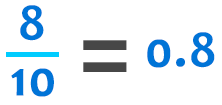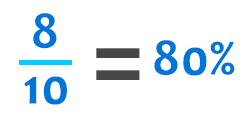
A fraction is a part of a whole. It describes how many parts it has.
There are 2 parts to a fraction. A numerator, and a denominator. The numerator is the top part of the fraction, and the denominator is the bottom part of the fraction.

Proper Fractions
A proper fraction is where the numerator is less than the denominator. For example, 8/10 is a proper fraction

Improper Fractions
An improper fraction is where the denominator is greater than the numerator. For example, 10/6 is an improper fraction.
Mixed Fractions
A mixed fraction is a fraction that has both a whole number and a fractional component.

Reciprocals
A reciprocal is where the numerator and denominator are reversed. By multiplying a fraction with its reciprocal, it will always equal to 1.

Equivalent Fractions
Equivalent fractions are fractions that have different numbers, but they have the same value.

Decimals
A decimal can also be used to represent fractions. For example, 0.8 is the same as 8/10.

Percents
A fraction can also be represented as a percent. For example, 8/10 is the same as 80%.



